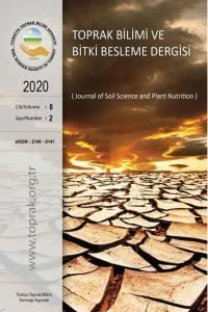Bazı çeltik çeşitlerinde toksik düzeyde demir uygulamasının taze kökte soğuk ekstrakte edilebilir demir ve çinko kapsamı ile Fe/Zn oranına etkisi
Çeltik çeşidi, taze kökte dithionite-sitrat-bikarbonat ile ekstrakte edilebilir demir ve çinko, Demir toksisitesi
The effect of toxic level iron application on fresh root with cold extractable iron and zinc content and Fe/Zn ratio in some rice varieties
Rice variety, extractable iron and zinc with dithionite-citrate-bicarbonate in fresh root, iron toxicity,
___
- Armstrong W, 1979. Aeration in higher plants. Adv. Bot. Res., 7:226-332.
- Aung MS, Masuda H, Kobayashi T, and Nishizawa NK, 2018b. Physiological and transcriptomic analysis of responses to different levels of iron excess stress in various rice tissues. Soil Sci. Plant Nutr.. 64:370-385.
- Bacha RE, Hossner LR, 1977. Characteristics of coatings formed on rice roots as affected by iron and manganese additions. Soil Sci. Soc. Amer. J., 41:931-935.
- Becker M, Asch F, 2005. Iron Toxicity – Conditions and management concepts. J. Plant Nutr. Soil Sci., 168:558-573.
- Chen CC, Dixon JB, Turner FT, 1980. Iron coatings on rice roots: morpology and models of development. Soil Sci. Soc. Am. J., 44:1113-1119.
- Greipsson S, Crowder AA, 1992. Amelioration of copper and nickel toxicity by Fe plaque on roots of rice (Oryza sativa). Can. J. Bot., 70:824-830.
- Hansel CM, Fendorf, S, Sutton S, Newville M, 2001. Characterization of Fe plaque and associated metals on the roots of mine-waste impacted aquatic plants. Environ. Sci. and Technol., 35:3863-3868.
- Jayawardena SDG, Watabe T, Tanaka K, 1977. Relation between root oxidizing power and resistance to iron toxicity in rice. Crop Sci. Plant Breed. Soc. J., 22:38-47 Kawase M, 1981. Anatomical and morphological adaptation of plants to waterlogging. Hortsci., 16:30-34.
- Liu WJ, Zhu YG, Smith FA, Smith SE, 2004a. Do iron plaque and genotypes affect arsenate uptake and translocation by rice seedlings (Oryza sativa L.) grown in solution culture? J. Exp. Bot., 55:1707-1713.
- Mendelssohn IR, Kleiss BA, Wakeley JS, 1995. Factors controlling the formation of oxidized root channels: a review. Wetlands 15:37-46.
- Smolders AJP, Roelofs JGM, 1996. The roles of internal iron hydroxide precipitation, sulphide toxicity and oxidizing ability in the survival of Stratiotes aloides roots at different iron concentrations in sediment pore water. New Phytol., 133:253-260.
- Snowden R, Wheeler BD, 1995. Chemical changes in selected wetland plant species with increasing Fe supply, with specific reference to root precipitates and Fe tolerance. New Phytol., 131:503-520. doi:10.1111/j.1469-8137.1995.tb03087.x
- Tadano T, 1975. Devices of rice roots to tolerant high iron concentrations in growth media. Japan Agric. Res. Q. 9:34-39.
- Tadano T, 1976. Studies on the methods to prevent iron toxicity in lowland rice. Memoirs of the Faculty of Agriculture, 10:22-88.
- Tanaka A, Loe R, Navasero SA, 1966. Some mechanisms involved in the development of iron toxicity symptoms in the rice plant. Soil Sci. Plant Nutr., 12:158-164.
- Taylor GJ, Crowder AA, Rodden R, 1983. Use of DCB technique for extraction of hydrous iron oxides from roots of wetland plants. Am. J. Bot., 70:1254-1257.
- Tinh TK, 1999. Reduction chemistry of acid sulphate soils: Reduction rates and influence of rice cropping. Acta Universitatis Agriculturae Sueciae, Agraria 206, Uppsala, Sweden.
- Wu L, Shhadi MY, Gregorio G, Matthus E, Becker M, Frei M, 2014. Genetic and physiological analysis of tolerance to acute iron toxicity in rice. Rice, 7,8. DOI: 10.1186/s12284-014-0008-3
- Zhang X, Zhang F, Mao D, 1998. Effect of Fe plaque outside roots on nutrient uptake by rice (Oryza sativa L.): zinc uptake. Plant Soil, 202:33-39.
- ISSN: 2146-8141
- Yayın Aralığı: Yılda 2 Sayı
- Başlangıç: 2012
- Yayıncı: Türkiye Toprak Bilimi Derneği
Güney AKINOĞLU, Ahmet KORKMAZ, AYHAN HORUZ
Abdurrahman AY, Rıdvan KIZILKAYA
Remzi İLAY, Meltem AKTAŞ, Nuri Burak ASLANTEKİN, Hasan ÖZCAN
Doğrusal kombinasyon tekniği kullanılarak arazi değerlendirme çalışması; Çarşamba Sefalı Köyü Örneği
İmanverdi EKBERLİ, COŞKUN GÜLSER
Ahmet KORKMAZ, Güney AKINOĞLU, AYHAN HORUZ
Sarımsak hasatıyla meydana gelen toprak kaybının belirlenmesi: Balıkesir-Altıeylül İlçesi örneği
Mehmet PARLAK, TİMUÇİN EVEREST
Zerrin CİVELEK, Nutullah ÖZDEMİR
Güney - Kazakistan'da sulu tarım yapılan toprakların bazı fiziksel özellikleri ve geçirgenlikleri
Maussymzhan MAUSSYMZHAN BEİSENBAYEVA, Sydyk DOSYMBEK, Aigul ZHAPPAROVA, Kadisha TOKTİBAYEVA, Gulnur UTENBAYEVA, Bolat MURZABAYEV, Zhainagul YERTAYEVA
